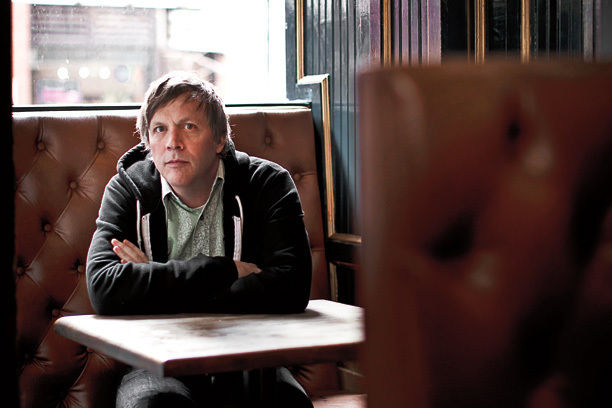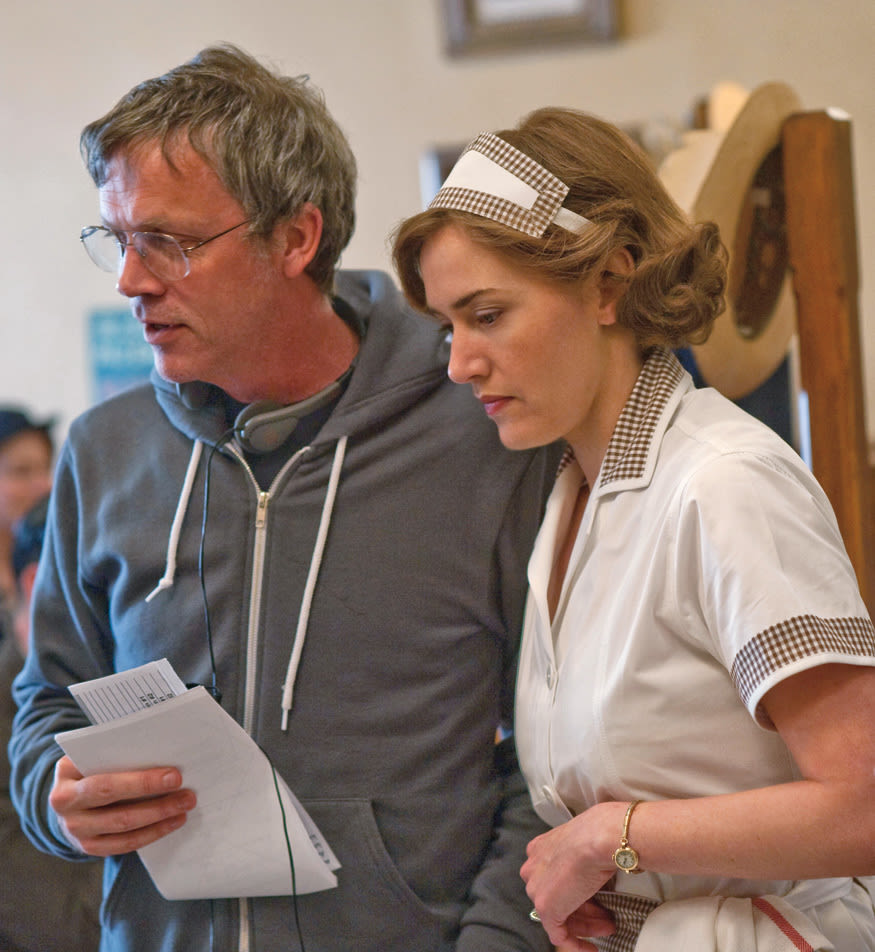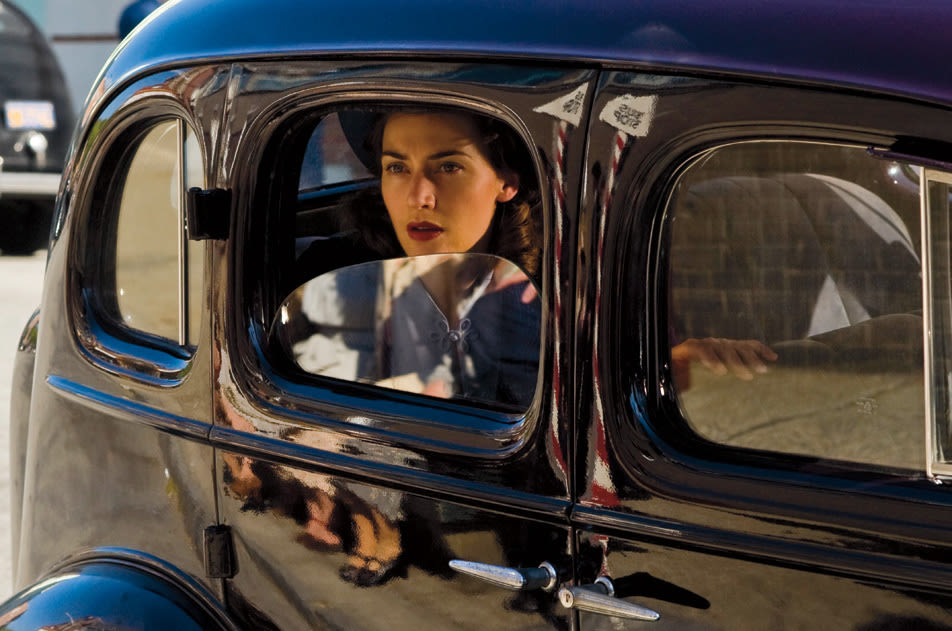
The Ladies' Man
IT’S A FRIGID FEBRUARY DAY in New York City. The streets are covered in snow, a historic storm is imminent, and director Todd Haynes has a cold. But in the post-production screening room of the company Technicolor, all talk centers on warmth. “Can you make it more butterscotch and honeycolored?” Haynes asks the resident colorist, inflecting his voice for emphasis with the treacly tone of a late-night phone-sex vixen.
This is the Academy Award–nominated director’s 13th month away from his Portland home and 27th week of post-production for the ambitious five-part HBO miniseries, Mildred Pierce, Haynes’s adaptation of James M. Cain’s sprawling novel about a divorced woman’s rise in business and fall with her daughter, famously personified in the 1945 film starring Joan Crawford. With the first two episodes set to debut on March 27, Haynes is whittling away at the final details. Wearing a plaid shirt, Adidas high tops, and his wavy brown hair tousled, still boyish-looking despite the encroaching gray, he is huddled in the dark theater with the colorist, the director of photography, the editor, and his assistant over a lunch of lemongrass pork. They’re color-correcting the pivotal fifth episode—when Mildred risks her hard-earned business on a gamble to get her daughter back—shot by shot, minute by minute.
“It’s still feeling drained,” he says of the next camera angle, between bites. A meticulous eye for detail, he’s eating now because he spent his entire lunch break tweaking a single 10-second camera pan. “It’s doing what we never do, but can you make it more warm?” he asks. This time, affecting a droll of an academic lecturer, he adds, “Put it through the traditional period drama filter.”
Of course, coming from the same director who cast Cate Blanchett as Bob Dylan in I’m Not There, Mildred Pierce is anything but the traditional period drama. Like his other films, it is a complex layering of genres and cultural references, a story as much about today as it is about its setting in the Great Depression. Most of all, it is Haynes’s latest reinvention of that all-too-rare genre in contemporary filmmaking: the female-centered drama. While over the 24 years of his independent film career, Haynes is equally known for his flamboyant, collage-like, boy rock movies I’m Not There and Velvet Goldmine, it is the narrative, genre-defined, women-driven domestic dramas that have won him his greatest victories, artistically and commercially.
Far From Heaven, the 2002 stylized scrutiny of a 1950s upper-middle-class woman (Julianne Moore) struggling to find herself amid suffocating social norms and suburban isolation, earned four Academy Award nominations, won numerous other awards, and became his first mainstream success. Haynes’s second feature, 1995’s Safe—about an emotionally bereft housewife (also Moore, in one of her first leading roles) who develops an allergy to the chemicals pervasive in modern life and retreats to a New Age center in search of an antidote—was named the best film of the 1990s by the Village Voice’s poll of critics.
“When young filmmakers say, ‘There’s one movie that made me want to be a filmmaker,’ half the time that’s Safe,” says indie superproducer Christine Vachon, who met Haynes in college and has produced all of his movies.
With Mildred Pierce, Haynes continues his practice of recasting the past, in particular the tribute he paid to the “women’s pictures” of the 1950s with Far From Heaven. The 1945 movie version of Mildred is a giant of the genre, one that spun the story closer to novelist Cain’s hard-boiled noir classics, such as The Postman Always Rings Twice and Double Indemnity, by adding a murder and upping Mildred’s glamour to make the costumes worthy of Crawford. Haynes, though, returned to Cain’s original story and cast the decidedly un-Crawford-like Kate Winslet as the bootstrapping Mildred, who kicks out her unemployed husband and struggles from waitress to restaurant owner. Despite its startlingly frank portrayals of her sexual relationships and her willingness to clomp over the era’s social stigmas against divorce and women in the workplace, Mildred Pierce is at heart an unrequited love story between Mildred and her daughter Veda (played by Evan Rachel Wood), whose insatiable hunger for status and wealth threatens to destroy her mother’s hard-earned success.
The gritty miniseries may be most viewers’ first introduction to Haynes, for unlike many other successful independent directors, he hasn’t chosen to parlay his critical success into a ticket to direct big-budget blockbusters. Yet while Mildred Pierce will beam his un-Hollywood tastes straight into the mainstream’s home entertainment centers, for Haynes it’s not about the accolades or the exposure; it’s about the best way to tell the story. “I want to do it as a miniseries so it can be as long as it needs to be, because there’s so much that goes on,” he said when he first started writing the script in late 2009. “But also I want it to be in people’s living rooms. It should come right through the portal into your domestic life, because female-driven stories relate to the domestic sphere and speak about the most basic relationships that we all participate in.”

Todd Haynes with actress Kate Winslet on the set of Mildred Pierce.
Image: David Johnson
BORN INTO A creative family, Haynes produced his first domestic dramas beneath a table in his Encino, California, home. With a stage made of blankets and desk lamps for lighting, he’d put on elaborate plays for his younger sister, Gwynneth, with her toy horses and dolls. He made his first film at age 9: a version of Romeo and Juliet in which he played all the roles but Juliet. (He wanted to play her, too, using double exposure for her scenes with other characters, but it didn’t hold up so well in the test reel.) His first serious film was about a young boy who had a fantasy of killing himself. Called The Suicide, it debuted at the local art house theater. Haynes was in ninth grade.
“He was one of those kids who seemed possessed by a knowledge of what he felt passionate about and what he wanted to do with that passion,” says Haynes's sister Gwynneth, now a psychologist living in Portland who also fronts the theatrical indie-pop band Sophe Lux. “And he was a Renaissance man—a wonderful writer, storyteller, actor, and painter”—skills he held fast, as he’s now almost legendary among casts and crews for his comprehensive grasp of all aspects of his productions, from art direction to costumes to music to how a shot is framed.
“Most filmmakers have strength in one thing or the other, but they don’t have quite the vision to pull it all together,” says Vachon.
Haynes studied art and semiotics at Brown University and then started an MFA at upstate New York’s Bard College, where he made his first film to catch the public’s eye, Superstar, a faux-documentary that chronicles singer Karen Carpenter’s rise to fame and struggle with anorexia. The film uses meticulously handmade sets and Barbie dolls as actors, with Haynes whittling away the plastic face as Carpenter’s anorexia progresses. The short became an underground classic, one of the top 50 cult films of all time according to Entertainment Weekly, even after legal threat from Richard Carpenter and Mattel nixed Superstar’s circulation. It also previewed the themes of female identity creation, repression, and isolation that Haynes would return to again and again.
Todd knows so specifically what he wants—about the music and the color and the timings and the pacings—that he’s way more involved than any other director I’ve worked with. —Affonso Goncalves, editor
Haynes moved to New York City in 1985 and went on to direct Poison (which won the Sundance Grand Jury Prize and is credited with inaugurating the New Queer Cinema movement), Safe, and Velvet Goldmine. As his acclaim grew, his love for the city waned. “What the world of success brings in terms of scene or celebrity has always been something Todd’s been humble and sheepish around,” says his sister. “It kind of creeps him out.”
So when he wanted to escape the city in 2000, she found him a place to stay in Portland. It was a misleadingly dry, beautiful spring, evoking the settings of the Douglas Sirk melodramas Haynes was emulating with a twist as he wrote Far From Heaven. Portland, thirsty for the celebratory he sought to abandon, quickly claimed him as half of our queer filmmaker duumvirate, along with Gus Van Sant.
“I thought it was the end of his creative life,” director Kelly Reichardt, a close New York friend since working with him on Poison, said of the move west. “Instead, it opened a whole new world.” He finished Far From Heaven, began I’m Not There, and developed an intimate circle of friends, including his assistant, Tanya Smith; local author Jon Raymond, who co-wrote the screenplay for Mildred Pierce; and honorary Portlander Reichardt, whom he introduced to Raymond, prompting them to collaborate on Reichardt’s Oregon-based, critically lauded features: Old Joy, Wendy and Lucy, and Meek’s Cutoff.
“My whole life changed in that one year,” Haynes says, “and I’ve been happy ever since.”

Kate Winslet stars as rags-to-riches restaurateur Mildred Pierce in Haynes’ newest film.
Image: David Johnson
HAYNES has been back in New York since January 2010 working on Mildred Pierce, and the city, perhaps still feeling spurned, isn’t being particularly welcoming. There’s that cold that’s sidelined every cast and crew member but one; his assistant’s rental car got a flat; a “historic” storm threatens to derail production, again. The problems have become a running joke during the mammoth undertaking.
“I was convinced Joan Crawford had cursed us,” says actress Evan Rachel Wood. “Lights started exploding, illness; anything that could go wrong went wrong. Mommy Dearest was lurking about, and every time something went wrong, we would just shake our fists in the air and go, ‘Joan!’”
Creating a five-hour miniseries in little over two years is akin to creating three movies for the price, time, and space of one—this by a director who has generally taken four years to make a film. “It’s certainly one of the biggest undertakings any director could take on,” says Wood. “Of course, there’s the length. But also it centers on one woman—a single mother in the Depression. It’s not something you’d immediately think would be able to be a five-part miniseries that would keep people’s attention.”
Women-driven dramas have been rare since the days of Bette Davis, Katharine Hepburn, and Crawford. In large part, investors aren’t willing to pay for them. (It took Haynes nearly two years to find financing for Far From Heaven because it lacked the then-sure bet of box-office queen Julia Roberts.) “I think in some ways, contemporary film audiences and the industry itself is more geared to men now than it ever has been,” he told NPR during Far From Heaven’s release. Indeed, the very term “melodrama” is now a pejorative.
With Mildred Pierce, Haynes has stepped away from the more mannered formalism of Far From Heaven in favor of a gritty naturalism. Inspired by the revisionist films of the 1970s, such as The Godfather, Chinatown, and The Exorcist, which updated their classic genres (gangster, noir, and horror, respectively) with subtle, naturalist sophistication, he wanted to revisit the mother-daughter melodrama as well as the Great Depression with a similar style. Instead of following the 1945 movie’s two-dimensional noir portrayal of suffering Mildred and insidious Veda, he sought to make both equally culpable in their complicated, dysfunctional relationship, just as The Godfather introduced psychological depth and ambivalence to mobsters.
He shot the miniseries with film stock and camera techniques from the 1970s to introduce an intimacy, subtlety, and texture that were anathema to noir, which was all about the contrast of darkness and light. The film’s dancing grain further combines with the grime and dirt of the sets to invoke the grittiness of the Depression, an aspect totally missing from the original film.
Haynes also looked to the revisionist films for their practice of injecting contemporary issues into historical stories. Chinatown’s plot, for example, reflected the newfound willingness of the late 1960s and early 1970s to point a finger at The Man for screwing over the masses to benefit the rich. “When you look at movies from that period,” he says, “they’re infused with the sense of the political and cultural discussions and arguments of their time, and because of that, they bring to their genres new or alternative meanings.”
The historical infusion works both ways, and using stories and genres from the past to reflect contemporary issues in a provocative, often saturated light is trademark Haynes. Poison and Safe deal with differing aspects of the AIDS crisis; Far From Heaven draws unsettling parallels between the culture of the early Bush years and the Eisenhower years. With Mildred Pierce, Haynes aims to reweave the now well-worn comparison between the current financial crises and the Depression by journeying through the 1930s with a surprisingly modern character. He and Raymond find Cain’s novel so exciting because it escapes the rote images of dust bowls and breadlines for an open portrayal of a sophisticated, sexually frank, socially aspiring middle class. Yet even without the 1945 movie’s murder, the ending isn’t pretty, and therein Haynes identifies his biggest connection, and warning, between the Depression and today.
“The story speaks to these intensely American yearnings and expectations of the middle class and how easily they can get corrupted,” he says. “This idea of ascension and giving your kids everything you never had can very easily slip into a kind of worship of wealth and privilege that can be damning.”
And that gets to the heart of why Haynes keeps returning to women-focused stories. While some gay men of his generation donned the trappings of their female idols and took to the stage, Haynes went the opposite route: peeling off the layers of female iconography to reveal the everyday forces that shape and constrain the lives of women—and by extension, gays and other social outsiders, both modern and historical. While movies like Wall Street might deal with themes of ascension and excess, such flashy Hollywood blockbusters don’t speak to most of their audiences’ experience. Domestic dramas do. “We don’t all live the westerns and the gangster movies and the romantic comedies, although we like to think we do,” says Haynes. “What we really live are the stories of love and betrayal and divorces and heartbreak. While we like to denigrate them by calling them ‘female genres’ or ‘women’s genres’ or ‘weepies,’ these are the stories we all live.”




